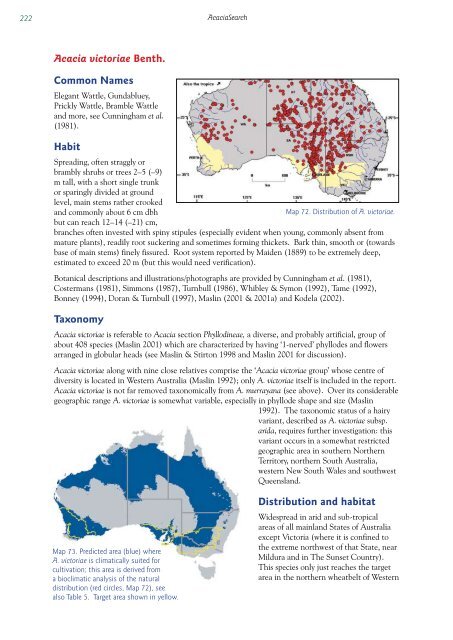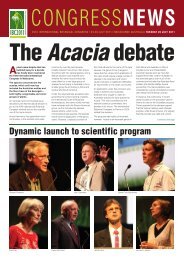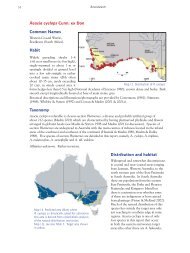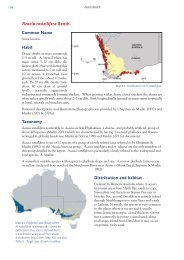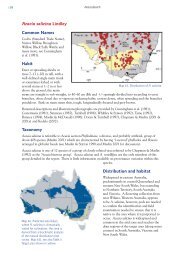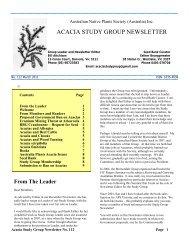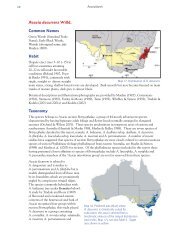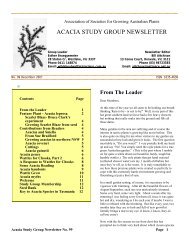Acacia victoriae Benth Common Names Habit Taxonomy Distribution and habitat
AcaciaSearch - World Wide Wattle
AcaciaSearch - World Wide Wattle
- No tags were found...
You also want an ePaper? Increase the reach of your titles
YUMPU automatically turns print PDFs into web optimized ePapers that Google loves.
222 <strong>Acacia</strong>Search<br />
<strong>Acacia</strong> <strong>victoriae</strong> <strong>Benth</strong>.<br />
<strong>Common</strong> <strong>Names</strong><br />
Elegant Wattle, Gundabluey,<br />
Prickly Wattle, Bramble Wattle<br />
<strong>and</strong> more, see Cunningham et al.<br />
(1981).<br />
<strong>Habit</strong><br />
Spreading, often straggly or<br />
brambly shrubs or trees 2–5 (–9)<br />
m tall, with a short single trunk<br />
or sparingly divided at ground<br />
level, main stems rather crooked<br />
<strong>and</strong> commonly about 6 cm dbh<br />
Map 72. <strong>Distribution</strong> of A. <strong>victoriae</strong>.<br />
but can reach 12–14 (–21) cm,<br />
branches often invested with spiny stipules (especially evident when young, commonly absent from<br />
mature plants), readily root suckering <strong>and</strong> sometimes forming thickets. Bark thin, smooth or (towards<br />
base of main stems) finely fissured. Root system reported by Maiden (1889) to be extremely deep,<br />
estimated to exceed 20 m (but this would need verification).<br />
Botanical descriptions <strong>and</strong> illustrations/photographs are provided by Cunningham et al. (1981),<br />
Costermans (1981), Simmons (1987), Turnbull (1986), Whibley & Symon (1992), Tame (1992),<br />
Bonney (1994), Doran & Turnbull (1997), Maslin (2001 & 2001a) <strong>and</strong> Kodela (2002).<br />
<strong>Taxonomy</strong><br />
<strong>Acacia</strong> <strong>victoriae</strong> is referable to <strong>Acacia</strong> section Phyllodineae, a diverse, <strong>and</strong> probably artificial, group of<br />
about 408 species (Maslin 2001) which are characterized by having ‘1-nerved’ phyllodes <strong>and</strong> flowers<br />
arranged in globular heads (see Maslin & Stirton 1998 <strong>and</strong> Maslin 2001 for discussion).<br />
<strong>Acacia</strong> <strong>victoriae</strong> along with nine close relatives comprise the ‘<strong>Acacia</strong> <strong>victoriae</strong> group’ whose centre of<br />
diversity is located in Western Australia (Maslin 1992); only A. <strong>victoriae</strong> itself is included in the report.<br />
<strong>Acacia</strong> <strong>victoriae</strong> is not far removed taxonomically from A. murrayana (see above). Over its considerable<br />
geographic range A. <strong>victoriae</strong> is somewhat variable, especially in phyllode shape <strong>and</strong> size (Maslin<br />
1992). The taxonomic status of a hairy<br />
variant, described as A. <strong>victoriae</strong> subsp.<br />
arida, requires further investigation: this<br />
variant occurs in a somewhat restricted<br />
geographic area in southern Northern<br />
Territory, northern South Australia,<br />
western New South Wales <strong>and</strong> southwest<br />
Queensl<strong>and</strong>.<br />
Map 73. Predicted area (blue) where<br />
A. <strong>victoriae</strong> is climatically suited for<br />
cultivation; this area is derived from<br />
a bioclimatic analysis of the natural<br />
distribution (red circles, Map 72), see<br />
also Table 5. Target area shown in yellow.<br />
<strong>Distribution</strong> <strong>and</strong> <strong>habitat</strong><br />
Widespread in arid <strong>and</strong> sub-tropical<br />
areas of all mainl<strong>and</strong> States of Australia<br />
except Victoria (where it is confined to<br />
the extreme northwest of that State, near<br />
Mildura <strong>and</strong> in The Sunset Country).<br />
This species only just reaches the target<br />
area in the northern wheatbelt of Western
<strong>Acacia</strong> <strong>victoriae</strong><br />
223<br />
Figure 36. <strong>Acacia</strong> <strong>victoriae</strong><br />
B – Young pruinose stems with<br />
persistent stipular spines.<br />
(Photo: B.R. Maslin)<br />
A – Mature plant near Mildura (one of the largest specimens seen of this species).<br />
(Photo: B.R. Maslin)<br />
C – Section of stem.<br />
(Photo: B.R. Maslin)<br />
D – Multi-stemmed shrub. (Photo: B.R. Maslin)<br />
E – Fruiting branches (pods prolific &<br />
papery). (Photo: J. Morse)<br />
G – Flowering branch (heads palecoloured<br />
& in racemes).<br />
(Photo: B.R. Maslin)<br />
F – 2 year old plants in trial at Morawa; juvenile plants brambly & spiny. (Photo: J. Carslake)
224 <strong>Acacia</strong>Search<br />
Australia but it is more common (in inl<strong>and</strong> areas) of the region in the east. <strong>Acacia</strong> <strong>victoriae</strong> is one of<br />
only four species in this report that occur in both the eastern <strong>and</strong> westen target areas (the other three<br />
are A. cyclops, A. hakeoides <strong>and</strong> A. murrayana). Over its extensive range A. <strong>victoriae</strong> occurs in a variety<br />
of <strong>habitat</strong>s but is commonly found in clay or loam on alluvial flats (subsp. arida occurs on s<strong>and</strong>, see<br />
Pedley 1980). Soils range from acid to alkaline or subsaline, <strong>and</strong> shallow to deep (Turnbull 1986). A<br />
comprehensive summary of its <strong>habitat</strong> characteristics is given in Hall et al. (1981a), Turnbull (1986)<br />
<strong>and</strong> Fowler & Fox (1995).<br />
Flowering <strong>and</strong> fruiting<br />
Phenology is variable. Flowering occurs from August to December (late winter to early summer) <strong>and</strong><br />
appears to vary depending upon where the plants occur (Fowler & Fox 1995). Although flowering is<br />
sometimes irregular it does not appear to be dependent upon the incidence of rain (Askew & Mitchell<br />
1978). Most sources record mature seeds occurring between about October <strong>and</strong> December, however,<br />
Pedley (1980) gives August to October <strong>and</strong> Bonney (1994) gives November to March. Pods are<br />
produced in great profusion <strong>and</strong> are easily collected by h<strong>and</strong> (shaking/threshing); they may be shed<br />
unopened or may open on the plant with the seeds remaining attached by the funicle.<br />
Biological features<br />
As summarised by Turnbull (1986) A. <strong>victoriae</strong> is an adaptable species that is moderately fast-growing,<br />
relatively short-lived (probably has a life-span of about 10–15 years) <strong>and</strong> moderately frost <strong>and</strong> salt<br />
tolerant. It is moderately drought tolerant but is killed by severe droughts, it recovers well after light<br />
grazing <strong>and</strong> is moderately fire tolerant when young (Askew & Mitchell 1978). It readily root suckers<br />
<strong>and</strong> has a large root system (Hall et al. 1981a); Maiden (1889) reported roots extend to more than<br />
20 m. Its coppicing ability requires further investigation; according to L. Thomson (pers. comm.)<br />
coppicing may possibly be related to the age of the plant (with older plants not coppicing well) or<br />
varies with provenance. The report by Thomson (1991) that A. <strong>victoriae</strong> coppices may possibly include<br />
observations from plants that are now referred to A. synchronicia. Further details on the biology of the<br />
species are given in Fowler & Fox (1995).<br />
Cultivation<br />
There are few reliable growth data for this species. However, in Iran it is reported to have attained 1.5<br />
m in one year, a similar growth rate to that of A. stenophylla (Webb 1973 unpublished, cited in Turnbull<br />
1986). It has shown good survival <strong>and</strong> growth in Israel <strong>and</strong> India, but has been less successful in dry<br />
tropical West Africa (CTFT 1983 unpublished, cited in Turnbull 1986).<br />
Trials<br />
Assessment trials of this species were recently established in plots on farml<strong>and</strong> at various locations in<br />
south-western Australia by the “Search” project (see Acknowledgements). At age 22 months plants<br />
of the best performing provenance of A. <strong>victoriae</strong> showed an average survival of 53% <strong>and</strong> an average<br />
height of 64 cm. The ‘best’ plot was located on a downslope site with heavy soil in northern Avon<br />
Wheatbelt IBRA region, with plants averaging 110 cm high. This growth performance for A. <strong>victoriae</strong><br />
was not as good as that achieved by A. murrayana <strong>and</strong> compared poorly with that of A. saligna.<br />
Pests <strong>and</strong> diseases<br />
Arboretum plants may be susceptible to root rot (Fowler <strong>and</strong> Fox 1995). Six species of Mistletoe have<br />
been recorded from this species in South Australia (Whibley & Symon 1992) <strong>and</strong> in central Australia<br />
there appears to be a relationship between mistletoe numbers <strong>and</strong> tree mortality (Reid et al. 1992).
<strong>Acacia</strong> <strong>victoriae</strong><br />
225<br />
Weed potential<br />
In some areas plant numbers may increase markedly during a succession of wet seasons <strong>and</strong> the species<br />
can become a nuisance, especially around watering points (Everist 1969).<br />
Wood<br />
Basic density values range from 739 kg/m 3 to 890 kg/m 3 (mean 814 kg/m 3 ) based on analyses of 2<br />
wood samples by CALM’s NHT-supported ‘Search’ project (unpublished data). Note: This study<br />
preferentially sampled young <strong>and</strong> adolescent plants. Ilic et al. (2000) gives the air-dry density before<br />
reconditioning as 804 kg/m 3 , based on 7 samples tested (note: this value was erroneously listed in<br />
the basic density column in this work). Based on our limited field sample this species produces a fair<br />
amount of sapwood relative to its dark brown heartwood <strong>and</strong> the wood is reasonably light relative to its<br />
volume; very minor end splitting occurred upon drying due to shrinkage in our wood sample.<br />
Utilisation<br />
Wood<br />
<strong>Acacia</strong> <strong>victoriae</strong> is listed as highly suitable for the production of fuel wood <strong>and</strong> charcoal abroad by<br />
Thomson et al. (1994).<br />
L<strong>and</strong> use <strong>and</strong> environmental<br />
Useful as a low windbreak <strong>and</strong> for soil stabilisation in dry country (Turnbull 1986), especially as it can<br />
readily regenerate from suckers <strong>and</strong> sometimes forms thickets; however, as already noted, in some<br />
areas numbers may increase markedly during a succession of wet seasons <strong>and</strong> can become a nuisance,<br />
especially around watering points. Because of its moderate to fast growth rate <strong>and</strong> moderate salt<br />
tolerance A. <strong>victoriae</strong> has been used in l<strong>and</strong> reclamation <strong>and</strong> mine site rehabilitation work in arid areas<br />
of Western Australia (Fowler & Fox 1995). Native st<strong>and</strong>s of this species provide good protection for<br />
small mammals <strong>and</strong> birds; its seeds are a source of food for many birds (Bonney 1994), including emus<br />
(Davies 1976, 1978).<br />
Fodder<br />
<strong>Acacia</strong> <strong>victoriae</strong> is a useful species for providing valuable food supplement for stock in arid <strong>and</strong> semiarid<br />
areas. However, it is killed by severe drought <strong>and</strong>, according to Petheram & Kok (1983), also by<br />
severe browsing, but recovers well following light browsing. The phyllodes have moderate palatability<br />
<strong>and</strong> digestibility (although foliage is usually not produced in particularly large amounts), <strong>and</strong> the seeds<br />
are a good source of protein for cattle. For further fodder details see Chippendale & Jephcott (1963),<br />
Askew & Mitchell (1978), Turnbull (1986) <strong>and</strong> Mitchell & Wilcox (1994).<br />
Human food<br />
The seeds of A. <strong>victoriae</strong> have good nutritional characteristics <strong>and</strong> they were commonly used as a food<br />
by aborigines; this is also the most important species in the emerging ‘bush tucker’ industry (see Maslin<br />
et al. 1998 for details). The branches exude a clear, tasteless gum which seems to have qualities for<br />
use in foods <strong>and</strong> industry (National Academy of Sciences 1979), however, under natural conditions<br />
the quantity of gum produced is not especially large. An analysis of gum characteristics is given in<br />
Anderson & McDougal (1988).<br />
Medicinal<br />
Results of studies by Mujoo et al. (2001) suggest that triterpenoid saponins from A. <strong>victoriae</strong> have<br />
potential as novel anticancer agents.<br />
Other uses<br />
It is a good source of pollen for bees, especially at Alice Springs (Boomsma 1972).
226 <strong>Acacia</strong>Search<br />
Potential for crop development<br />
<strong>Acacia</strong> <strong>victoriae</strong> is regarded as having only moderate prospects as a crop plant for high volume wood<br />
production. However, in the drier inl<strong>and</strong> areas where it grows naturally there are not that many<br />
options available. It is ranked as a priority 3 species <strong>and</strong> its growth characteristics suggest that it<br />
may have some potential for development as a phase crop (Table 6), although its vigorous suckering<br />
propensity may present difficulties for its management. <strong>Acacia</strong> <strong>victoriae</strong> is an adaptable, primary<br />
colonizer species characterized by having a fast to moderately fast growth rate, an extensive <strong>and</strong><br />
deep root system <strong>and</strong> a fair degree of edaphic adaptability (including alkaline <strong>and</strong> subsaline soils).<br />
Its moderate fodder value <strong>and</strong> its importance as a source of seed for human consumption adds to<br />
its attraction as a potential crop plant. The main disadvantages of A. <strong>victoriae</strong> are its spiny nature<br />
(particularly the young plants), poor stem form (rather crooked) <strong>and</strong> the small dimensions of its wood<br />
(although some provenances, plants from near Mildura for example, do produce reasonable quantities<br />
of woody biomass, see Fig. 36A). Wood density values are moderately high which lowers the species<br />
attraction for use in reconstituted wood products. Because A. <strong>victoriae</strong> produces large quantities of<br />
seed (presumably at an early age) this would result in the creation of a soil seed bank that may lead to<br />
weed problems in adjacent or subsequent annual crops. (Alternatively young seedlings may possibly<br />
be treated as a form of green manure.) One strategy for avoiding soil seed build up is to harvest<br />
plants before they flower or fruit; however, for this to be a viable strategy the plants will need to have<br />
produced suitable quantities of wood by then. Under natural conditions A. <strong>victoriae</strong> relies on wet<br />
conditions for growth <strong>and</strong> it remains to be seen how well it will grow as water becomes limiting in<br />
cultivation (limited experience from dry area silviculture abroad has produced variable results). The<br />
propensity for A. <strong>victoriae</strong> to vigorously root-sucker in nature may or may not be advantageous in<br />
cultivation, it depends whether or not this attribute is required (or expressed) for the system in which<br />
it is placed. As noted by Everist (1969) if rainfall is high this species may regenerate rapidly <strong>and</strong> form<br />
undesirable thickets.<br />
The area predicted to be climatically suitable for the cultivation of A. <strong>victoriae</strong>, based on its natural<br />
climatic parameters but excluding areas with


